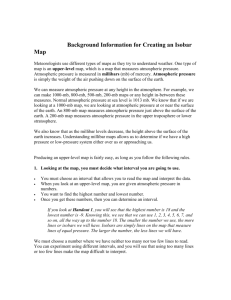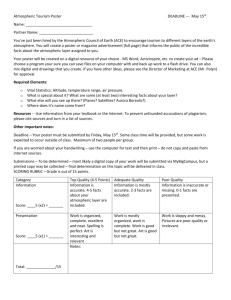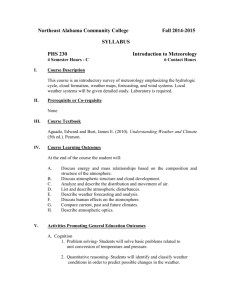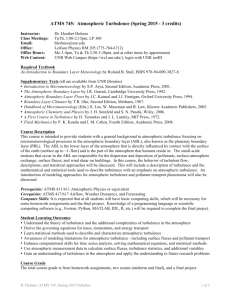Lab
advertisement
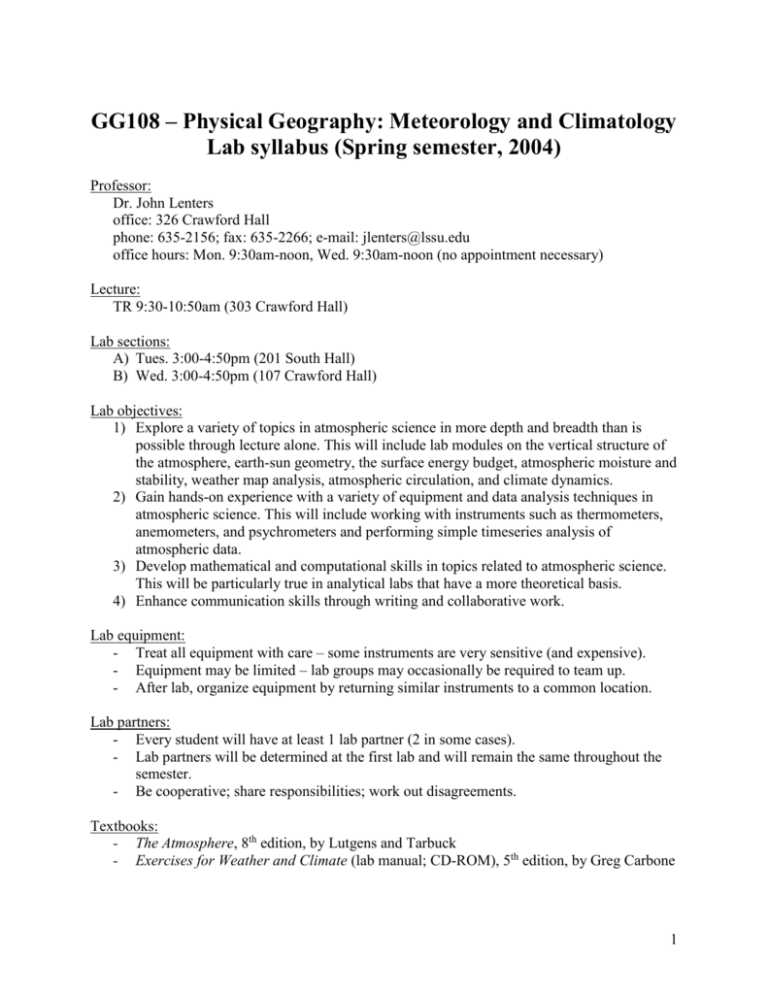
GG108 – Physical Geography: Meteorology and Climatology Lab syllabus (Spring semester, 2004) Professor: Dr. John Lenters office: 326 Crawford Hall phone: 635-2156; fax: 635-2266; e-mail: jlenters@lssu.edu office hours: Mon. 9:30am-noon, Wed. 9:30am-noon (no appointment necessary) Lecture: TR 9:30-10:50am (303 Crawford Hall) Lab sections: A) Tues. 3:00-4:50pm (201 South Hall) B) Wed. 3:00-4:50pm (107 Crawford Hall) Lab objectives: 1) Explore a variety of topics in atmospheric science in more depth and breadth than is possible through lecture alone. This will include lab modules on the vertical structure of the atmosphere, earth-sun geometry, the surface energy budget, atmospheric moisture and stability, weather map analysis, atmospheric circulation, and climate dynamics. 2) Gain hands-on experience with a variety of equipment and data analysis techniques in atmospheric science. This will include working with instruments such as thermometers, anemometers, and psychrometers and performing simple timeseries analysis of atmospheric data. 3) Develop mathematical and computational skills in topics related to atmospheric science. This will be particularly true in analytical labs that have a more theoretical basis. 4) Enhance communication skills through writing and collaborative work. Lab equipment: - Treat all equipment with care – some instruments are very sensitive (and expensive). - Equipment may be limited – lab groups may occasionally be required to team up. - After lab, organize equipment by returning similar instruments to a common location. Lab partners: - Every student will have at least 1 lab partner (2 in some cases). - Lab partners will be determined at the first lab and will remain the same throughout the semester. - Be cooperative; share responsibilities; work out disagreements. Textbooks: - The Atmosphere, 8th edition, by Lutgens and Tarbuck - Exercises for Weather and Climate (lab manual; CD-ROM), 5th edition, by Greg Carbone 1 You will be graded on: 1) Lab reports (60%) 2) Attendance (40%) - Your lab grade counts as 30% of the course grade - Your lowest lab grade will be dropped Grading scale: 90–100%: A– / A /A+ 80–90%: B– / B / B+ 70–80%: C– / C / C+ 60–70%: D– / D / D+ < 60%: F Lab reports (60%): - Lab reports essentially consist of following the instructions given in your lab manual, performing and recording the necessary calculations, and answering the questions that appear throughout the particular lab module that you are working on. You are expected to give thoughtful, complete, and accurate answers to each of the questions. I will come around to each lab group to provide assistance and evaluate your progress. Based on my evaluation, I will assign a “lab report grade” to your lab group as a whole (A: excellent, B: good, C: average, D: poor, F: little or no work). My evaluation will take into account the quality of your lab report as well as your lab group’s ability to correctly answer specific questions relating to the lab material. Attendance (40%): - Lab attendance will be recorded by taking roll at the beginning of class. - In fairness to your lab partners, anyone arriving more than 10 minutes late will not receive credit for being in attendance. (But you can still receive a lab report grade.) Lab schedule (subject to minor changes): – January – Week 1 (Jan. 12-16): Week 2 (Jan. 19-23): Week 3 (Jan. 26-30): – February – Week 4 (Feb. 2-6): Week 5 (Feb. 9-13): Week 6 (Feb. 16-20): Week 7 (Feb. 23-27): – March – Week 8 (Mar. 1-5): Week 9 (Mar. 8-12): Week 10 (Mar. 15-19): Week 11 (Mar. 22-26): Week 12 (Mar. 29-Apr. 2): – April – Week 13 (Apr. 5-9): Week 14 (Apr. 12-16): Week 15 (Apr. 19-23): Lab 1: Vertical structure of the atmosphere Lab 2: Earth-sun geometry Lab 4: The surface energy budget Lab 6: Atmospheric moisture Lab 7: Saturation and atmospheric stability Lab 8: Cloud droplets and raindrops Lab 14: Climate controls No classes (spring break) Lab 9: Atmospheric motion Lab 15: Climate Classification Lab 17: Climatic variability and change Lab 18: Simulating climatic change Lab 10: Weather map analysis; Experimental lab: Temperature, wind, and wind chill Lab 11: Mid-latitude cyclones Lab 12-13: Thunderstorms and tornadoes; Hurricanes 2






